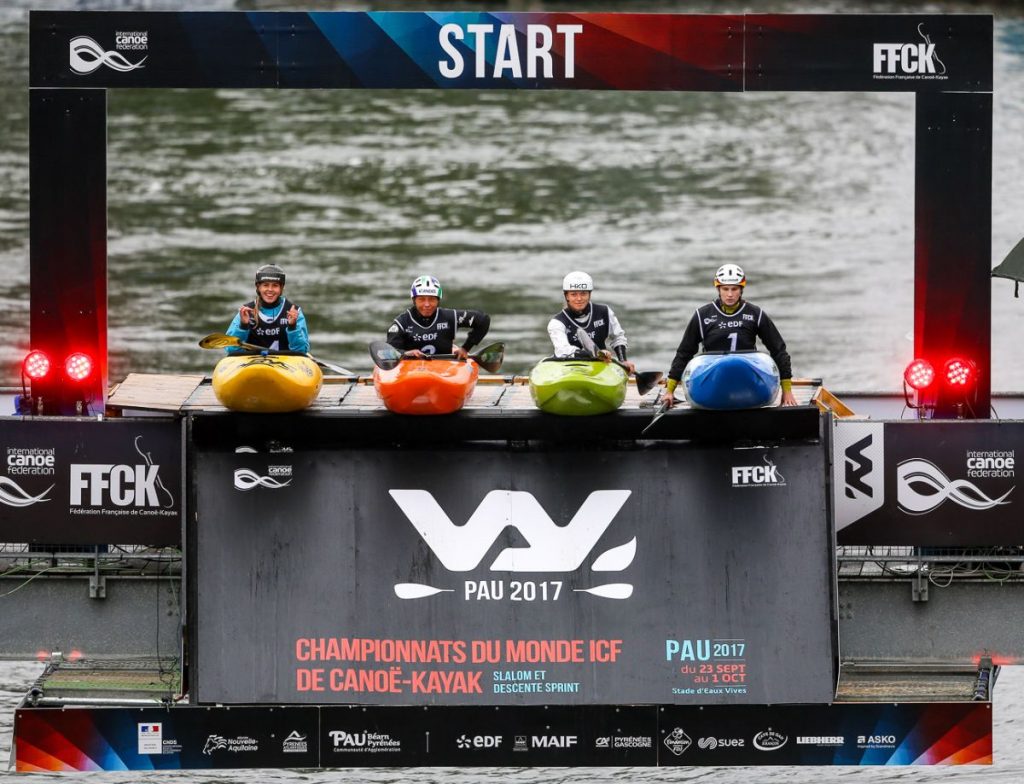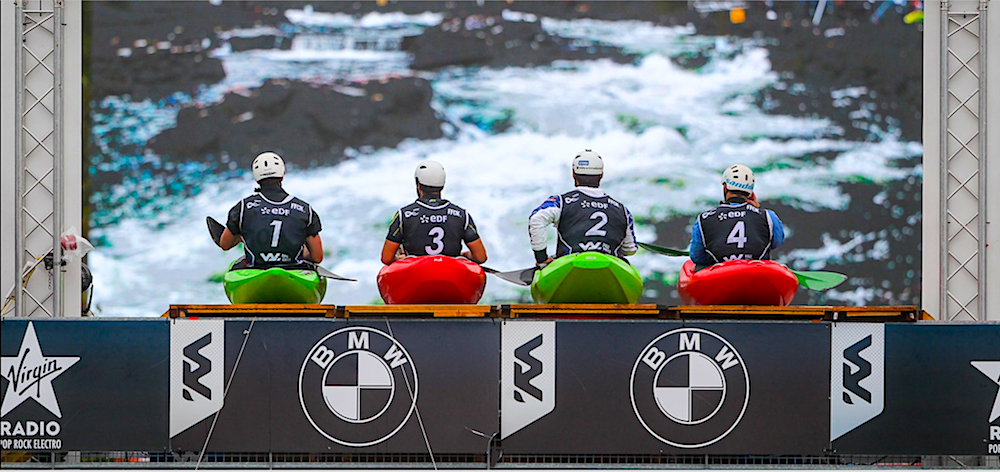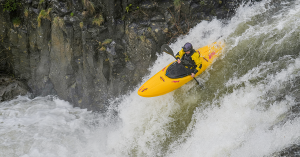With the recent International Canoe Federation (ICF) board vote to include men’s and women’s Extreme Slalom at the 2024 Paris Olympics, whitewater is poised to receive more exposure than ever before. As commercial boats take to the start line, the industry stands to benefit.

The Olympics will look a little different for 2024, with the inclusion of a new whitewater discipline, “extreme slalom.” This news has the paddlesports world buzzing, and for good reason.
For many athletes, competing at the Olympics serves as the pinnacle of athletic achievement. Arguably the world’s most famous international athletic competition, the Olympics are also one of the oldest. The first modern Olympic Games took place in 1896, with 43 events including track and field, gymnastics, swimming, wrestling, cycling, tennis, weightlifting, shooting, and fencing. Canoe and kayak racing became full medal sports at the 1936 Berlin Games, though canoe slalom made its debut much later. First welcomed to the fold at the 1972 Munich Games, slalom, still the only whitewater event, did not return to the Olympic Games again until 1992, in Barcelona.
“Modernize, or die. Faced with this reality, the ICF has chosen to promote extreme slalom”
The inclusion of canoe and kayak slalom in the Olympics can be costly. Host cities have to fund the building of highly specialized whitewater courses or find nearby rivers to act as the host venue. As the Olympic committee seeks to make the games appealing to younger audiences and affordable for host cities, cutting costs and athlete participation numbers, sports federations have a difficult choice. Modernize, or die. Faced with this reality, the ICF has chosen to promote extreme slalom, an event where four athletes race head to head down a whitewater course, navigating gates and executing a mandatory roll in an interpretation of what is commonly known as Boater Cross or Boater X.
Popularized at kayak events, festivals, and races worldwide, Boater Cross is a crowd favorite for the inevitable mayhem and the potential for anyone to win. When faced with the choice of modernizing or dying, extreme slalom provides seemingly the perfect answer to keep kayaking in the Olympics. It utilizes existing resources while simultaneously generating interest and participation in the sport, especially from a younger audience. What makes its inclusion in the Olympics noteworthy for the industry is that it is the first time plastic boats- and a paddling style more familiar to the general public- will be introduced.
The inclusion of extreme slalom is good news for kayak manufacturers, distributors, and enthusiasts as it undoubtedly opens the door to new markets and opportunities. “One of the International Olympic Committee’s (IOC) missions is ‘Sport for All’ and advancement of sport in society. The Olympic Games, therefore, by definition, are supposed to boost mass sports participation,” write Katia Engalycheva & Jean-Loup Chappelet in their study, Sport Participation in Host Countries before and after the Olympic Games: Do the Games Change Something? Though little conclusive research exists, Chappelet and Engalycheva explore the “wide-spread belief…that megaevents, such as the Olympic Games, create community excitement and lead to a so-called “trickle down” effect where people are inspired to become more active due to the successes of Olympic athletes and the staging of such a high profile event.”
The viewership of the 2016 Olympic Games in Rio ranged from 26 million to 3.6 billion. Regardless of the size of the trickle, it seems inevitable that exposure of that status to a global and celebrated stage wouldn’t result in at least a small increase in participation or knowledge of whitewater. Additionally, the potential for participants to win the celebrated and revered Olympic Gold permits a potential increase in funding for the development of the sport, meaning more participants across more countries. Which, in turn, translates to more boats bought and sold for years to come.
“Without the Olympics, we would struggle to maintain the level of competition, development, and support we currently provide.”
“It is no secret that the Olympic Games provides a large slice of the funding that allows us to support canoeing around the world,” explains the ICF. “Without the Olympics, we would struggle to maintain the level of competition, development, and support we currently provide.” This support includes slalom development camps in countries where gear and access to coaching are hard to come by, such as India, Argentina, and Iran. Suppose the ICF puts their weight behind helping to develop extreme slalom as well as slalom. In that case, this likely means getting as many up and coming athletes as possible into commercial whitewater boats.
Even so, including extreme slalom in Paris does not automatically bring ready or wide-reaching benefits for the industry in everybody’s eyes. From the athlete perspective, while extreme slalom brings heightened exposure and excitement for the paddlesport events, it does not increase the number of paddlesport athletes, as only those who already compete in a canoe slalom discipline at the Olympic Games are eligible to participate. It is also important to note that introducing extreme slalom to Paris comes at the cost of medals in the sprint disciples, a decision that, for some, feels like promoting good television over athleticism.

Ultimately, the question is, does good television translate to sales? Though disappointed by the current athlete quotas, “It is an opportunity,” says Honza Lasko of Zet Kayaks. “Time will tell if it benefits us or not, but the whitewater community as a whole will benefit. There will be more competition between athletes, manufacturers, and events, etc.”
For Jochen Lettmann of Lettmann Kayaks, elevating extreme slalom to the Olympic stage will benefit all whitewater paddlers “because it will lead to new designs for that event,” which in turn, will lead to “new interesting kayaks to run and play the rivers in the world.” On the flip side, Emily Jackson of Jackson Kayak worries that regulations of both the sport and course will inevitably limit potential innovation in boat design. She also points to the unlikeliness of immediate exposure benefit for any company as Olympic regulations prevent any branding or logos on competition gear.
“While including extreme salmon in the Olympics isn’t the most revolutionary or groundbreaking opportunity for paddle sports, it is undeniably an opportunity”
Says Paul Robertson of Palm Equipment, “Any format with argy-bargy and an easily distinguished winner is going to make a good TV spectacle.” But, he points out, “It’s hard to see a big range of opportunities for stand-alone products (for example, a specific extreme slalom kayak) unless it is something that clubs and young paddlers begin to practice and do outside of the ICF races.” The benefit of extreme slalom will rely on how clubs and the ICF choose to embrace and promote the event: legitimate competitive field, or spectacle not worth additional training, time, and investment?
Yet, if you look closely, the benefit has already begun. Despite the controversy, as clubs and federations seek to give athletes the opportunity to take home the first-ever extreme slalom gold, excitement and stoke are building, and whitewater boats are already being purchased. More, other disciplines are starting to pay attention. If the debut of extreme slalom goes well, it could open the door for more whitewater-based fields, or at the very least, change the direction of funding and sport development in the future.
While including extreme salmon in the Olympics isn’t the most revolutionary or groundbreaking opportunity for paddle sports, it is undeniably an opportunity and one that brings with it future and potential. Surely, it is better for the future of all paddle sports, whitewater or not, than losing the whitewater events entirely.
More opportunity is always better than no opportunity, and this is a very good one at that.
By: KS Publishing Editorial Team.
Article published in the 2021 Paddler’s Guide



